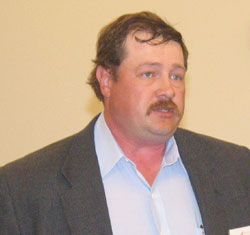
During the BIF Producer Applications Committee meeting, a panel of speakers shared perceptions of a national animal ID system. Pictured, left to right, are NCBA Animal ID Commission Chair Allen Bright, Antioch, Neb.; University of Georgia Extension Educator Ronnie Silcox; cattle feeder John Haverhals, Hudson, S.D.; and cow-calf producer Marshall Edleman, Willow Lake, S.D.


